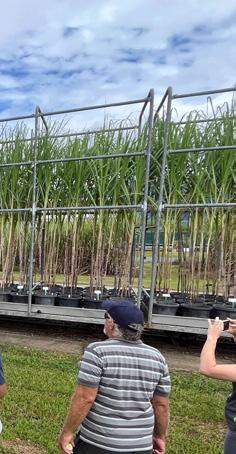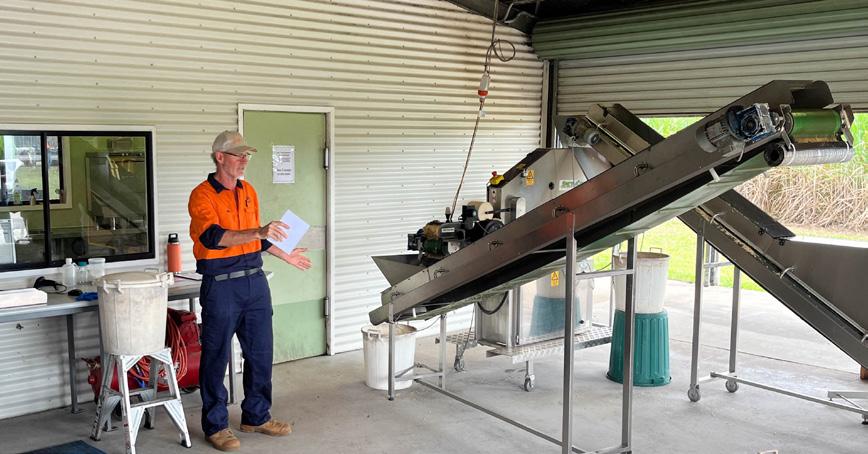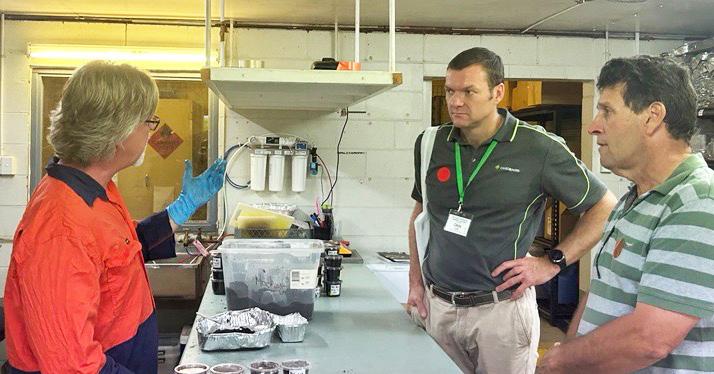
4 minute read
WORKING TOGETHER GROWING TOGETHER
The theme for the 2023 Australian Society of Sugar Cane Technologists (ASSCT) conference 'Working Together - Growing Together' was on point according to CANEGROWERS Senior Manager Membership Engagement & Innovation Matt Kealley, who said there is no better opportunity to share research, products and expertise within the sugarcane industry.
The conference brought together representatives from the growing, milling and research components of the industry to discuss current developments in research and technology. As well as the in-depth presentations, panels and keynote speakers, the conference included a highly successful agricultural field day held at the Sugar Research Australia (SRA) Meringa Station.
Advertisement
Matt said the ASSCT, held in this year in Cairns during April, provides the only forum where the sugarcane industry can come together to present and discuss industry research that can benefit growers and millers.
“It also featured keynote speakers, panels, and workshops on industry issues and opportunities such as diversification, mill reliability and the sugar plus roadmap,” Matt said.
“Attending these sessions can help growers keep informed and gives the opportunity to stay up to date on the latest research, technologies, and best practices.
“The networking opportunities to meet and connect with researchers, extension professionals, millers, growers and key industry people in the Queensland sugarcane industry value chain is valuable and the field trips allow participants to see the research in action.”

The SRA Field Day at Meringa provided participants with a meander through a wide range of current research areas.
The day was very well attended by growers, millers, extension staff, scientists and other industry professionals.
CANEGROWERS Farm Business Resilience Project Manager
Chris Gillitt said the day included as many as 15 different practical demonstrations including two guided walks.
“One of these was a fascinating walk around the grounds to view the photoperiod houses and Spectracane facilities used in variety development,” Chris said.
“Dr Felicity Atkin, from SRA, explained that the photoperiod houses were built to provide a means to extend the flowering period of cane used as parents for crossing. This is achieved by controlling the day length and temperature to improve flowering, which are then used for crossing to produce seeds which are then subjected to the rigorous selection process which narrows down potential candidates from up to 100,000 new seedlings!
“There was also a walking tour of the research being conducted on alternatives to imidacloprid for control of the cane grub pest. The progress was encouraging although some of the details of the products had to remain commercial in confidence until research is completed and products are able to be registered for use in sugarcane.”
The demonstration of the Harvest Mate decision support tool online app attracted much attention with a lot of enthusiastic questions and answers discussed. The tool aims to simulate the economic cost and benefits (based on extensive harvesting trials and data) arising from a practice change in key harvesting parameters such as fan speeds and machine travelling speeds.
The app provides growers and contractors with a suite of relevant information to enable better decision making around how the crop is harvested, and also provides each party with data that can help them reach an agreement on implementation of the practice change and using that to negotiate the commercial arrangements to do so (considering costs, risk, and return).
Harvest Mate went on to win the best research paper at the ASSCT conference.
Participants could also “dropin” with lead researchers who hosted discussions on topics such as progress with Yellow Canopy Syndrome (research on role of invertebrate vectors), SugarPATH
BioSensors (device for detecting diseases in sugarcane), drone applications for research (sensors and artificial intelligence for strengthening variety performance analysis), AutoWeed (greenon-green spot spraying technology) and much more!

The Industry Roadmap and Panel Q&A session provided the opportunity to reinforce the important role that research, innovation and technology play in the industry’s vision for the future.
Dr Jason Eglington President of ASSCT and SRA Executive Manager Variety Development, Rachele Sheard Australian Sugar Milling Council CEO, Burn Ashburner CANEGROWERS
Senior Manager Industry, Roslyn Baker SRA CEO, Stephen Ryan Australian Cane Farmers Association General Manager and Elton Miller Department of Agriculture and Fisheries (Queensland) Executive Director provided the insight into the industry’s road map for a sustainable future during the Q&A session.
“I would encourage growers to attend future conferences and to connect with the industry researchers at SRA,” Matt said. Growers can check out the 2023 Abstract Book of the presented research at www.assct.com.au


Key Takeaways And Research Of Note
Development of the decision-support tool ‘Harvest Mate’: agronomic algorithms
This paper examined the development of these algorithms and the functionality of Harvest Mate, a new tool that incorporates both agronomic and economic considerations to determine the most economically optimal harvester settings.
Reviewing the results of soil tests identifies opportunities to improve nutrient management in the Wet Tropics

Records of available soil-test results for the Tully, South Johnstone and Mulgrave sugarcane production districts were collated and reviewed. It is evident that soil acidity and nutrient deficiency, specifically calcium and magnesium, are impacting the productivity of older ratoon crops and are likely to be affecting the performance of legume covercrops grown during the traditional fallow period. Opportunities to alleviate soil-chemical constraints, overcome nutrient deficiencies and refine on-farm nutrient management were discussed.
Profitability and environmental implications of innovative practice changes and irrigation improvements
The economic and environmental benefits of practice changes and irrigation improvements were explored based on three grower case studies in the Bundaberg, Burdekin and Mackay regions that consider grower investments in best management practices, including irrigation changes.
The economic benefit was positive for all farms, ranging from $29 to $377 per hectare per year.
The same data were used to calculate indicators of environmental performance (per tonne of harvested cane) using the Cane Life Cycle Assessment (CaneLCA) tool. There were reductions in fossil-fuel use, greenhouse-gas emissions, and a potential for water pollution curtailment.










